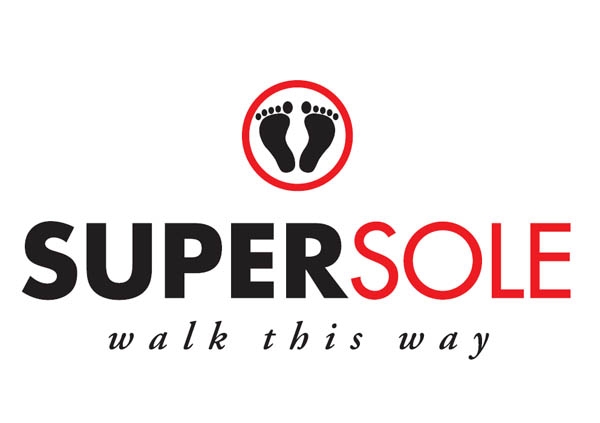Supersole and diabetes
Diabetes mellitus is a chronic disease. There are many diseases resulting from diabetes, e.g. changes in the connective tissue, neuropathy (impaired sense of touch) and reduced circulation. Seen from the foots point of view, this is an unfortunate combination. There is a risk that you will not feel pressure from your shoe or folds in your stockings. This may induce sores on your feet which only heal with great difficulty.
Foot sores on a diabetic foot may quickly develop into serious injuries that require a surgical procedure. The sores will most often develop underneath the foot, on the toes, between the toes or on the heel. In the beginning, they may not look like much, but it is still essential that you have them checked and treated by a chiropodist as soon as possible. All the possible problem areas make it important that you establish a routine for your feet.
Chiropodist
Sores call for a chiropodist
As a diabetic, you should always consult a chiropodist who can give you a status of your foot. The chiropodist will examine whether you have an impaired sense of touch. If this is the case, it is important that you continue to consult a chiropodist with special training within the area of diabetic feet. If you have or have had foot sores, it is also essential that you see a chiropodist regularly. Physiotherapists can examine functionality and the status of your joints, but when it comes to sores, it demands the expert knowledge of the chiropodist.
Take care of your feet
Give your feet a thorough check-up every day. The skin must be whole and smooth, both on top and underneath. Use a mirror if it is difficult to see the whole foot.
Clean feet
Keep your feet clean with a brief, daily wash in lukewarm, soapy water. Test the temperature of the water with your hands, before you put your feet in. If you have an impaired sense of touch in your feet, you may get burns without even noticing. Avoid long foot baths that reduce the resistance of the skin. Dry your feet well and take special care between the toes in order to prevent athletes foot (tinea pedis). If the skin on your feet becomes too dry, it may rupture and crack. The feet must be moisturised after each foot bath. Avoid moisturising between the toes. Your doctor or chiropodist can recommend suited creams.
Hot or cold feet
If you have a tendency towards hot, moist feet, you can use an antiperspirant available at the pharmacists. Cold feet may, however, be countered by massage, foot gymnastics and circulation exercises. Your physiotherapist can help you by suggesting specific exercises. It is also important to make sure that there is enough room in socks and shoes. Avoid warming your feet with an electric heating cushion or the likes. It is better to use a woollen blanket or woollen socks.
Toe nails
Toe nails must be cut straight across. If you have hard nails, it is best to cut them right after your foot bath while they are still soft. Make sure there are no sharp corners or edges. If you have problems with your toe nails, a chiropodist can help you.
Your feet grow A LOT!
Change your shoes
Your feet grow during the day, and with some people they swell. Therefore you should change your shoes regularly during the day. Before you put on your shoes, you should check your shoes with your hand for rough spots or other kinds of unevenness in the shoes that may irritate the skin. It often takes very little to make a hole, especially if your feet swell during the day.
Callous skin
If you get pressure marks, corns or very callous or even cracked skin, it is a sign of overload. Never try to remove callous skin, corns or warts yourself. Over-the-counter drugs for the removal of warts and corns should be avoided because they often damage the skin. See a chiropodist instead who can help you find the reason for the callous skin.
Blisters
Never puncture a blister that has developed due to faulty footwear or overload of the feet. The fluid in the blister protects the new, delicate layer of skin, until it can be subjected to wear. Put a dry piece of gauze on the blister to protect the delicate skin, if the blister ruptures.
If there is blood or pus in the blister instead of a clear fluid, you should contact your doctor or chiropodist.
Athletes foot (Tinea pedis)
Athletes foot is seen as white, soft coverings or flaming red areas, most commonly on the forefoot, or even as small beads on the foot sole or all over the foot. Athletes foot is treated partly with a fungicide available at the pharmacists, and partly by avoiding creating a hot, moist environment for the foot, in which the fungi will thrive. Change your socks daily.
Bare feet
Never go barefoot. Not even in your own home. If you have a reduced circulation or impaired sense of touch in your feet, you must avoid walking around barefoot. It is also wise to protect your feet against sharp objects on the beach. When vacationing in warm countries, the sand can become so hot from the sun that you risk burning your feet. Walking around barefoot outside is especially dangerous because of the risk of cuts and infections.
Never go barefoot!
Treat your feet nicely
Your footwear must fit you
The right shoe size is extremely important for a diabetic. The wrong type of shoe may cause sores and even amputation, if the worst comes to pass. Because the size and shape of the foot changes with time, it is important to ensure that your shoe size is correct. Always buy your shoes in the afternoon. At this time of day, your feet are at their largest. It should never be necessary to break in a pair of shoes. An easy way to check a pair of shoes is to draw a contour of your foot on a piece of paper and then add a few millimetres at the toes. Remember to draw the contour in the afternoon, when your feet are at their largest. Cut out the model and see if it fits smoothly in your shoes (no bends). Use it when you buy shoes, but also to check if your old footwear still fits. New footwear should only be used ½ hour the first time. Then take the shoe off and check the skin for any pressure marks (red marks) and blisters. Use a mirror or have someone help you control your feet.
Before you put on your footwear, you should check that there are no pebbles or sand in your shoe. Make a habit of checking and shaking your shoe, before you put it on.
Clogs
The muscles of the feet do not function normally when you wear clogs – not even the ones with flexible soles – but clogs can be appropriate in certain working situations. If you wear clogs at work, it is, however, important to use soft, flexible shoes in your own time.
Socks
A sock which is too tight and wrinkled or a seam in the sock may cause pressure marks and sores. It is a good idea to turn the seam of the sock outside and always choose a sock which is big enough. This also goes for nylons.
Physiotherapist or chiropodist
If you have foot sores or an impaired sense of touch, you should have your chiropodist make you a protective inlay. Chiropodists have special training within this field. If you have healthy feet without sores or other conditions, you can get help from a physiotherapist, who may even help you by making you a pair of dynamic insoles. This can give you better balance, functionality when walking and increased circulation. Being a diabetic, it is important that your insoles do not take up too much space in your shoes, thus squeezing your foot.
The insole must fit your foot
In order to stimulate the circulation in your foot, it is important that the insole is dynamic, so that it does not prevent the musculature of your foot from working. To ensure that the insole fits your foot optimally, you should make appointments for control examinations with your physiotherapist. In the beginning, it is important only to use the insole for short periods of time (5-10 minutes). Immediately after use you must check that there are no pressure marks or blisters. Step up the use of the insoles slowly.
What can SuperSole do for YOU?
SuperSole have developed an insole especially for the diabetes foot – “Care” This sole is developed with a special kind of shock absorption. Apart from being very durable, it also has a memory, which means that it shapes itself precisely after the contours of your foot, thus providing added comfort and maximum relief.
Apart from the optimal shock absorption and relief, the insole is fitted with a very hard-wearing surface. The surface is ultra thin, which means that the shock absorption of the insole is not decreased. Furthermore, this surface makes it easy to take the shoes on and off, so that the socks do not fold. Just like all the other SuperSole insoles, the Care insole can be adjusted and fitted a countless number of times, making it possible for you to have it adjusted for maximum comfort and relief.
Increased circulation
SuperSole is the most dynamic insole on the market, which means that the foot works naturally – to your advantage. In principle, the insoles functions as a booster. This ensures that your foot has optimal circulation, and this also helps prevent creation of sores and safeguard that you posture is correct.
When you have chosen SuperSole for your diabetic foot, you are guaranteed that it is made by a specially trained physiotherapist.










